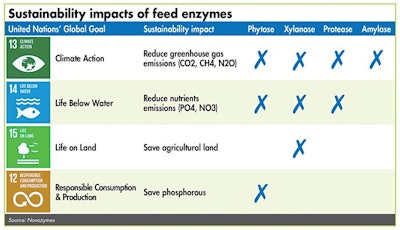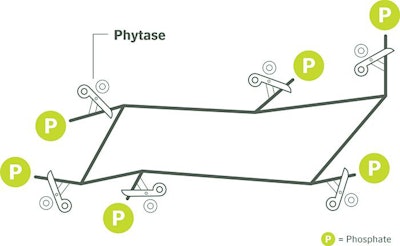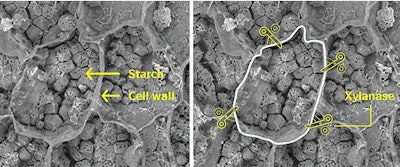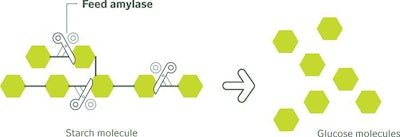
As the world’s population grows and many regions enjoy improved economies, animal products are increasingly in demand. This growth, however, is not without its drawbacks.
Due to feed production and manure emissions, animal production comes with a considerable environmental impact. And in fact, the total greenhouse gas emissions from livestock supply chains is estimated at the equivalent of 7.1 billion tons of CO2 — about 14.5 percent of all greenhouse gases caused by human activity.
This has been more than enough reason for the United Nations’ Food and Agriculture Organization (FAO) to investigate the impact of these emissions and suggest a range of ways to reduce them.
One such suggestion is the improvement of feed conversion rates (FCR) — and that’s where enzymes come in. Enzymes are the fastest growing category of all feed additives.
Enzymes' role in digestion
Enzymes are proteins that can speed up biochemical reactions tremendously. They are created by nature and are essential to all life — playing a major role, for instance, during digestion. In digestive processes, enzymes act like small scissors, cutting feed ingredients into pieces so they can more readily release energy and nutrients.
This point gets to the core of why enzymes represent a growing opportunity for the animal feed industry. Of course, the digestive systems of production animals are not always sufficient to make use of all nutrients and energy in their feed; as a result, some is wasted with manure. But when added to the feed, industrially produced enzymes can help maximize the feed conversion ratio.
This benefits the farmer because costly ingredients can be saved. Meanwhile, it’s also a win for the environment; if less feed needs to be produced, fewer emissions will escape.
In these ways, feed enzymes are now helping advance four of the United Nation’s Global Goals for Sustainable Development, increasing the sustainability of the animal feed and production industries as a whole.
But before we get to that, let’s take a look at a few of the types of enzymes tackling these issues today.
Phytase reduces phosphorus emissions
Phytases are enzymes that release phosphorus, a mineral naturally bound in feed and one which would otherwise be indigestible to animals such as pigs and poultry. Phosphorus is critical to animal growth, so the use of phytase saves inorganic phosphorus and reduces phosphorus emissions via manure.
Phosphorus, which is also used as a fertilizer in modern agriculture, is only found in limited amounts in the ground and managing it carefully is essential for future food production. Minimizing phosphorus emissions has the added benefit of reducing the risk of algae blooms in lakes and rivers. This is, of course, a good thing, as too much algae in natural waters spoils fishing opportunities, which can negatively impact rural economies.
Additionally, not only does phytase reduce phosphorus emissions as previously mentioned, but it actually takes more energy to produce inorganic feed phosphate than an equivalent amount of phytase.

A large part of the phosphorus in feed ingredients is bound in a molecule called phytate. Phytase degrades phytate and releases the phosphate so that inorganic phosphorus supplementation can be almost fully replaced by phytase in pig and poultry diets. | Novozymes/DSM
Fiber-degrading enzymes cut input usage
In a similar way, not all protein and starch in animal diets is utilized — in this case because it hides behind fibrous cell walls. Fiber-degrading enzymes such as xylanases break down these cell walls, improving energy and protein utilization, thereby reducing the need for protein and energy-rich raw materials. Using fiber-degrading feed enzymes also reduces nitrous oxide (N2O) and methane (CH4) emissions — two strong greenhouse gases — from manure.
But the effect of xylanases extends beyond the animal itself. Humans use vast amounts of land for agricultural production, which puts pressure on forests and biodiversity. Feed savings achieved with xylanases reduces the amount of land needed to produce feed for animals as well as the energy used by agricultural machinery to plow and harvest that land.

Starch and protein are trapped within complex cell wall structures in cereals. Feed xylanases degrade the cereal cell walls, making more protein and starch available for animal growth. | Ninfa Rangel Pedersen, Novozymes
Protease improves protein digestibility
Protein is an essential nutrient in livestock production, and animal feed often contains large amounts of protein-rich ingredients, such as soy. Only part of the protein is digestible, however, and the undigested portion is responsible for ammonia (NH3), nitrate (NO3) and nitrous oxide (N2O) emissions into the environment via manure.
Feed proteases degrade protein into smaller pieces to improve its digestibility — for instance, in poultry feed. This improves the feed’s protein value and reduces manure’s harmful emissions.
Environmentally speaking, ammonia is an undesirable gas because it contributes to soil acidification. Soil acidification can then lead to reduced fertility of agricultural land, and can even kill trees. Nitrate in manure is washed out of the soil with rainwater and into lakes and rivers, where it serves as fertilizer and contributes to undesirable algae bloom.

Protein in animal feed needs to be degraded into small peptides (mono-, di- or tripeptides) to be absorbed and utilized for tissue building, etc. Feed proteases complement the animal's own digestive proteases to facilitate effective protein degradation in the animal's digestive tract and ensure more protein is utilized. | Novozymes/DSM
Amylase increases energy value
Amylases are starch-degrading enzymes. Feed amylases can help poultry by degrading starch in the feed, thus increasing the energy value of the feed. This allows farmers to save energy-rich feed ingredients such as animal fat or vegetable oil. The saved animal fat can then be used as a feedstock for production of biodiesel, which can help reduce the use of fossil fuels, cut CO2 emissions and lower contribution to climate change.

Starch consists of chains of glucose molecules. Feed amylase assists the animal's own digestive amylases by cutting starch molecules into glucose molecules, thereby improving the energy value of feed. | Novozymes/DSM
Enzymes contribute to UN’s Global Goals
Phytases, xylanases, proteases and amylases are the workhorses of the feed enzyme world, driving progress on four of the U.N.’s 17 Global Goals.
For instance, consider:
- The use of xylanase for pigs can reduce greenhouse gas emissions by 3 to 8 percent and the potential global savings is roughly 20 million tons of CO2e annually.
- The use of amylase in Brazilian broiler production can reduce contribution to climate change by roughly 750,000 tons CO2e annually.
- The use of protease for poultry can reduce ammonia emissions by 3 to 4 percent, resulting in a potential global savings of roughly 130,000 tons of NH3 annually.
- The use of phytase can almost eliminate supplementation of inorganic phosphorus to pigs’ feed, resulting in a potential global savings of roughly 1.7 million tons of phosphate rock annually.
The Global Goals, agreed upon in 2015 by 193 world leaders, are a road map toward sustainable development. As it turns out, feed enzymes may have a larger role to play in that effort than initially thought.













